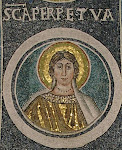In European countries, particularly France, the debate over Islamic dress affects how to integrate Muslim immigrants and balance their rights with the majority population who find the dress an affront to women.
But in Egypt, the dynamic is different. Here, dressing in traditional Muslim garb is at odds with the secular government, which some view as autocratic and corrupt.
The debate underscores the gulf between the more secular elite, which wields economic and political power, and the disenfranchised masses who increasingly find solace in strict Islamic observance.
And women wearing the full body covering, the niqab, is the most visible outward sign.
A decade ago, the niqab was almost never seen in Egypt and it is still a minority fashion. Most women wear a scarf that covers the hair but not the face, often with tight jeans or clinging tops, despite clerics' complaints that formfitting clothes violate the whole point of "Islamic dress."
But today it is normal to see women in niqab, hidden under a veil that covers everything but the eyes, billowing black robes that cloak the body's shape, and often gloves. They are found at universities, teaching in schools, working in government offices and private companies, strolling along the Nile and riding on motorcycles behind their husbands.
The inspiration is Salafism, a movement that models itself on early Islam. Its doctrine is similar to Saudi Arabia's, and many trace its spread to Egyptians returning home from work in the kingdom and to Saudi-backed religious satellite TV stations.
Actually, the Wikipedia article on Salafi traces this more specifically:
Stéphane Lacroix, a postdoctoral fellow and lecturer at Sciences Po in Paris, also affirmed a distinction between the two: "As opposed to Wahhabism, Salafism refers here to all the hybridations that have taken place since the 1960s between the teachings of Muhammad bin ‘Abd al-Wahhab and other Islamic schools of thought. Al-Albani’s discourse can therefore be a form of Salafism, while being critical of Wahhabism."[44]
But despite their beginnings "as two distinct movements", the migration of Muslim Brotherhood members from Egypt to Saudi Arabia and Saudi King Faisal's "embrace of Salafi pan-Islamism resulted in cross-pollination between ibn Abd al-Wahhab’s teachings on tawhid, shirk and bid‘ah and Salafi interpretations of ahadith (the sayings of Muhammad).[45]
Regardless, it should still be pointed out that the terms "Salafi" and Wahhabi are not necessarily synonymous. Wahhabism has been variously described as a subset of Salafism,[6] a derogatory synonym for Salafism,[37] or a formerly separate current of Islamic thought that appropriated "language and symbolism of Salafism" until the two became "practically indistinguishable" in the 1970s.[46]
Comparison with Islamism
Salafism differs from the earlier contemporary Islamic revival movements of the 1970s and 1980s commonly referred to as Islamism, in that (at least many) Salafis reject not only Western ideologies such as Socialism and Capitalism, but also common Western concepts like economics, constitutions, political parties and revolution.
Salafi Muslims often promote not engaging in Western activities like politics, "even by giving them an Islamic slant."[47] Instead, it is thought that Muslims should stick to traditional activities, particularly Dawah. Salafis promote Sharia (Islamic law) rather than an Islamic political program or state.
(Note: My bolding. Also, I left the footnotes in and you can go to the Wikipedia article to follow up on them if you like.)
We can thus understand the niqab as a statement in favor of Shariah Law over secualr governments. And now returning to the AP article, we can understand that as universities and governments agencies seek to curtail the niqab, and many women defend this practice, the real battle is between secular governmental law and Islamic Shariah Law:
"This is not a security battle. It is a cultural, political battle," said Diaa Rashwan, an analyst who monitors such groups. "There is no cohesion within the state on how to tackle it."
For some women, wearing the Islamic garb is an implicit rebellion against the system. Many are outspoken in defending their beliefs, refuting the notion that Muslim women are oppressed and cloistered.
"I tell a girl who wants to wear the niqab that she has to be ready to fight for it," said al-Assal's mother, Iman el-Shewihi, who veiled herself 15 years ago - the first in her family to do so.
The 45-year-old woman, who is working on her doctorate in Islamic law, says that like her daughter, she has paid a price; She has been denied teaching jobs at her university in Tanta, north of Cairo.
Read it all here.





No comments:
Post a Comment